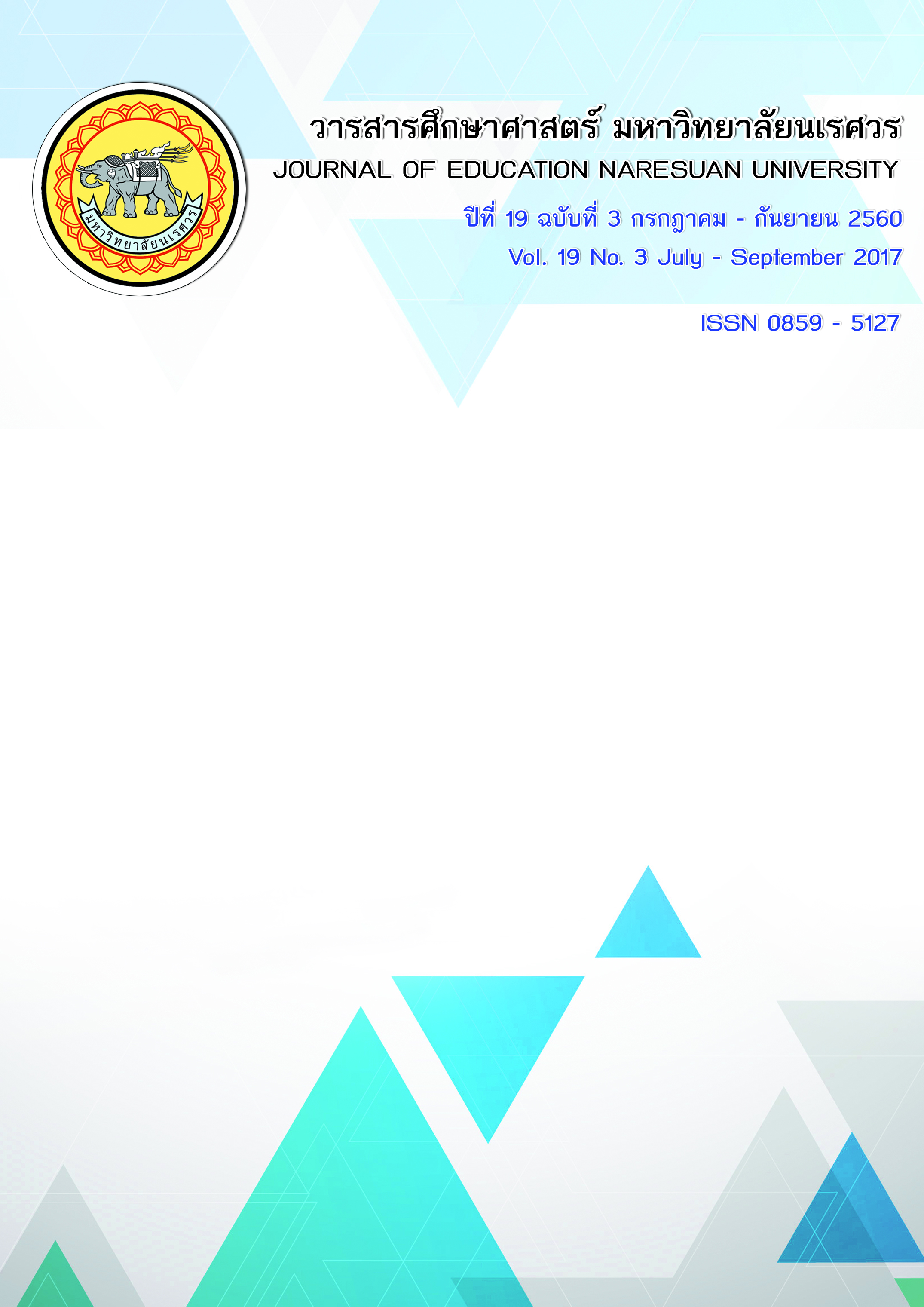การพัฒนารูปแบบความสัมพันธ์เชิงสาเหตุขององค์การนวัตกรรมที่มีอิทธิพลต่อการยอมรับการใช้งานการเรียนอิเล็กทรอนิกส์ผ่านความสามารถ ด้านคอมพิวเตอร์ การรับรู้ประโยชน์ และการรับรู้ความง่าย ของอาจารย์สังกัดมหาวิทยาลัยเอกชนในเขตกรุงเทพมหานคร
Main Article Content
Abstract
งานวิจัยนี้มีวัตถุประสงค์เพื่อ 1) พัฒนารูปแบบความสัมพันธ์เชิงสาเหตุขององค์การนวัตกรรมที่มีอิทธิพลต่อการยอมรับการใช้งานการเรียนอิเล็กทรอนิกส์ผ่านตัวแปรความสามารถด้านคอมพิวเตอร์ การรับรู้ประโยชน์ และการรับรู้ความง่าย ของอาจารย์สังกัดมหาวิทยาลัยเอกชนในเขตกรุงเทพมหานคร 2) ตรวจสอบความสอดคล้องของรูปแบบความสัมพันธ์เชิงสาเหตุของอิทธิพลองค์การนวัตกรรมต่อการยอมรับการใช้งานการเรียนอิเล็กทรอนิกส์ 3) ศึกษาขนาดอิทธิพลของตัวแปรที่ส่งผลต่อการยอมรับการใช้งานการเรียนอิเล็กทรอนิกส์กลุ่มตัวอย่างคืออาจารย์สังกัดสถาบันอุดมศึกษาเอกชนในเขตกรุงเทพมหานคร จำนวนตัวอย่าง 447 คน เครื่องมือที่ใช้ในการวิจัย คือแบบวัดองค์การนวัตกรรม ความสามารถด้านคอมพิวเตอร์ การรับรู้ประโยชน์ และการรับรู้ความง่ายและการยอมรับการใช้งานการเรียนอิเล็กทรอนิกส์ซึ่งมีค่าสัมประสิทธิ์ความเที่ยงระหว่าง 0.936 ถึง 0.981 การวิเคราะห์ข้อมูลโดยใช้สถิติบรรยาย และการวิเคราะห์เพื่อตรวจสอบความตรงของรูปแบบความสัมพันธ์เชิงสาเหตุระหว่างองค์การนวัตกรรมกับการยอมรับการใช้งานการเรียนอิเล็กทรอนิกส์ใช้การวิเคราะห์เชิงยืนยันด้วยโปรแกรม LISREL ผลการวิจัย พบว่า รูปแบบความสัมพันธ์เชิงสาเหตุแสดงอิทธิพลขององค์การนวัตกรรม ที่มีต่อการยอมรับการใช้งานการเรียนอิเล็กทรอนิกส์ผ่านตัวแปรความสามารถด้านคอมพิวเตอร์ การรับรู้ประโยชน์ และการรับรู้ความง่าย สอดคล้องกลมกลืนกับข้อมูลเชิงประจักษ์ (x2 = 51.91;
df = 40; p = . 09829; GFI = .98; AGFI = .96; RMR = 0.017) ตัวแปรเชิงสาเหตุอธิบายความแปรปรวนของการยอมรับการเรียนอิเล็กทรอนิกส์ได้ร้อยละ 67 โดยตัวแปรองค์การนวัตกรรมมีขนาดอิทธิพลรวมสูงสุดเท่ากับ .69 และตัวแปรที่มีอิทธิพลทางตรงสูงสุด คือ การรับรู้ประโยชน์ รองลงมา คือ การรับรู้ความง่าย องค์การนวัตกรรม และความสามารถด้านคอมพิวเตอร์ มีขนาดเท่ากับ 0.45, 0.20, 0.17 และ 0.08 ตามลำดับ ตัวแปรที่มีอิทธิพลทางอ้อมสูงสุด คือ องค์การนวัตกรรม มีขนาด 0.52 รองลงมา คือ ความสามารถด้านคอมพิวเตอร์ และการรับรู้ประโยชน์ มีขนาดอิทธิพล 0.17 และ 0.13 ตามลำดับ
DEVELOPMENT OF CAUSAL MODEL OF INNOVATIVE ORGANIZATION AFFECTING THE ADOPTION OF E-LEARNING MEDIATED THROUGH COMPUTER ABILITY, UTILITY PERCEPTION AND EASY PERCEPTION OF PRIVATE UNIVERSITY INSTRUCTORS IN BANGKOK
This research objectives were 1) to develop a causal relationship model illustrating the effects of organization innovation on adoption of e-learning mediated through computer ability, utility perception and easy perception of private university instructors in Bangkok,
2) to validate the conformance between empirical evidence and the model, and 3) to examine the effect size of factors affecting adoption of e-learning. The samples consisted of 447 private university instructors in Bangkok. They were selected by stratified random sampling. The research instruments were questionnaires on organization innovation, computer ability, utility perception and easy perception which had the reliability coefficients between 0.936 to 0.981. Data analysis was executed with descriptive statistics and assessment of validity of the causal relationship model between organization innovation and e-learning adoption through LISREL. Significant finding could be summarized as follows:
The causal relationship model illustrating the effects of organization innovation on e-learning adoption mediated through computer ability, utility perception, and easy perception of instructors in private universities. The validity assessment of the causal relationship model, conformed to the empirical evidence (x2 = 51.91; df = 40; p = .09829; GFI = .98; AGFI = .96; RMR = 0.017), whereas the variables in the causal relationship model explained 67% of the variance of e-learning adoption. The highest total effect variables was innovation organization which total effect sizes 0.69. The highest direct effect variables were utility perception followed by easy perception, innovation organization and computer ability which direct effect sizes were 0.45, 0.20, 0.17, and 0.08 respectively. The highest indirect effect variables were innovation organization which effect sizes was 0.52 followed by computer ability and utility perception which effect sizes were 0.17 and 0.13 respectively.
Article Details
The owner of the article does not copy or violate any of its copyright. If any copyright infringement occurs or prosecution, in any case, the Editorial Board is not involved in all the rights to the owner of the article to be performed.

